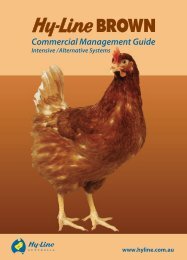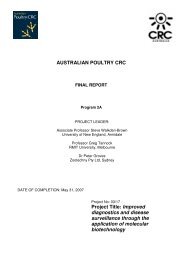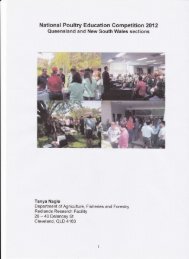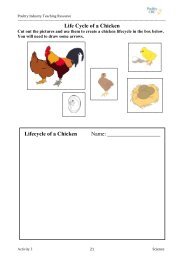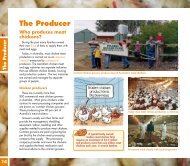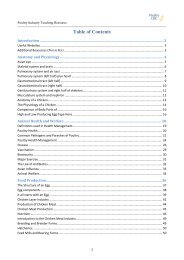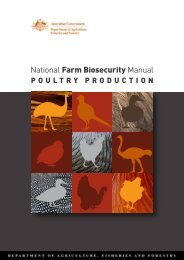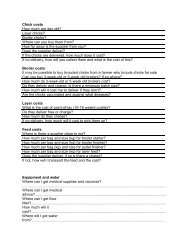You also want an ePaper? Increase the reach of your titles
YUMPU automatically turns print PDFs into web optimized ePapers that Google loves.
2.3.3 MeasurementsBody weights were recorded at 11 days of age, 14 days of age and weekly thereafter. Feed refusalswere weighed at the time of bird weighing, and additions to each feeder were allocated on a needsbasis and weighed each time.At 21 days of age, one bird per cage was euthanazed using CO 2 gas for dissection. The proventriculus,gizzard, duodenum, jejunum, and ileum were weighed with and without digesta contents. Gizzard andduodenum digesta pH was recorded. Digesta was collected from the duodenum and immediatelyrefrigerated for particle size analysis. All organs were cleaned of external fat and mesentery beforeweighing. At 35 days of age, the dissection procedure was repeated.At 25d all birds were fasted for six hours, feeds and birds were weighed, and excreta trays placedunder birds for excreta collection. Excreta were collected for three consecutive days at the same timeof day that the trays were placed under the birds on the first day of collections. Daily collections ofexcreta were pooled and frozen at -20˚C. The birds and feeds were weighed at the commencementand completion of excreta collection. Excreta were used for nitrogen corrected apparent metabolisableenergy (AME n ) determination.2.3.4 Marker preparation and administrationChromium mordanted hay (used as a solid phase marker) was prepared according to the methodoutlined by Udén et al. (1980). The prepared hay was ground using a 1 mm screen on a Christy-Hunthammermill, desiccated, and pressed into 1000±5 mg tablets using a manual screw-down tablet press.Cobalt-ethylenediamine tetraacetic acid (Co-EDTA) powder, used as a liquid phase marker, containedin a commercially available 1.0cm 3 gelatine capsule was also used to measure digesta transit time.Cobalt-EDTA was prepared according to the method outlined in Udèn et al. (1980). Birds receivedtwo 1000 mg Cr-mordanted hay tablets each, and one Co-EDTA capsule in a one-off (force-fed)administration. All birds were allowed ad libitum access to feed and water immediately before andafter marker administration. Markers were administered to ten 29d-old birds per treatment over cleanexcreta collection trays, with excreta collected at 1, 2, 3, 4, 5, 6, 7, 8, 10, 12, and 24h post markeradministration for marker retention time and recovery analyses. Samples were frozen after eachaddition of fresh excreta, and until the time of analysis.2.4 Experiment 2Based on the findings of the first experiment, it was concluded that there was an effect of the particlesize of the grain used in the diet. It was postulated that the type of grain used in the diet would alsohave an effect on the performance of the broiler, and thus a second grain of greatest significance to theAustralian broiler industry (wheat) as well as sorghum was used in the second experiment. Thehypotheses for the second experiment were that; the particle size of the grain in the pelleted dietswould affect performance, gut development, and enteric microbial status, irrespective of grain type,and, the aforementioned parameters will be affected by grain type.The second experiment was conducted at the University of New England Animal House facility,located in Armidale, New South Wales, Australia, during September and October of 2005. Armidaleis located at 30˚30'E, 151˚40'S and is approximately 1000 m above sea level. Due to its altitude, anddistance from the coast, Armidale is in a cool-temperate climate zone, with mean daily temperaturesranging between 3.7˚C and 17.6˚C in September, and 7.0˚C to 21.2˚C in October (Australian Bureauof Meteorology, 2006). Climate-controlled rooms were thus needed for the experiment.10



